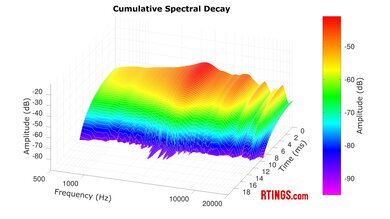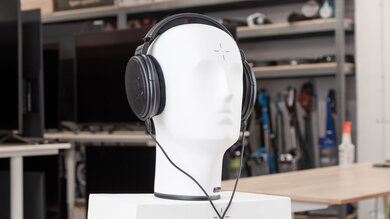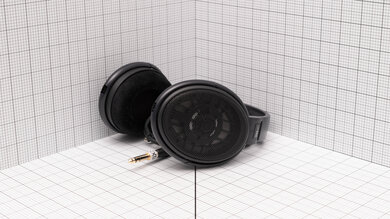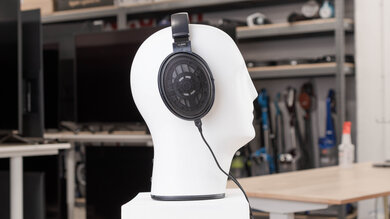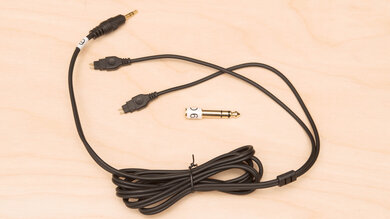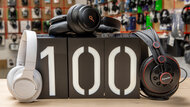The Sennheiser HD 6XX are open-back wired headphones. They're a collaboration between Massdrop and Sennheiser and can only be purchased on the Drop website. They build on the blueprint of the popular Sennheiser HD 650 and revamp it with a slight aesthetic facelift and subtle modifications, like the inclusion of a 1/8" plug to facilitate connecting mobile devices.
Our Verdict
The Sennheiser HD 6XX aren't suitable for sports and fitness. They're stable enough for casual listening sessions, but they aren't designed for sports use, and they may fall off your head during more intense physical exercise. They're decently comfortable, but these bulky over-ears aren't very easy to bring on the go. Plus, it's very easy for the cable to get snagged on something as you're running.
-
Well-built and decently comfortable.
-
Not stable enough for exercise.
-
Not very portable.
-
Leaks a lot of noise.
The Sennheiser HD 6XX are bad travel headphones. These decently comfortable headphones are passive, so you don't have to worry about them running out of battery. However, due to their open-back design, they leak a lot of noise, which can annoy those around you. They also can't block out background noises like bus and plane engines or voices from other passengers.
-
Well-built and decently comfortable.
-
Not very portable.
-
Terrible noise isolation.
-
Leaks a lot of noise.
The Sennheiser HD 6XX are poor for office use. They're decently comfortable, and thanks to their wired connection, you don't have to worry about them running out of battery. However, due to their open-back design, they don't block out background noises typically found in an office, like chatter from other coworkers. Also, they leak a lot of noise, which can be distracting for people around you.
-
Well-built and decently comfortable.
-
No microphone.
-
Terrible noise isolation.
-
Leaks a lot of noise.
The Sennheiser HD 6XX are wired-only headphones, so they aren't suitable for wireless gaming.
The Sennheiser HD 6XX are okay for wired gaming. You can plug them into your PC or Xbox and PlayStation family controller, but they don't have a microphone, so you can only receive audio. Thanks to their wired connection, they have low latency, and they're decently comfortable. However, they lack low bass, so you may not feel the deep thump and rumble in action-packed scenes.
-
Well-built and decently comfortable.
-
Consistent audio delivery.
-
No sound customization features.
-
No microphone.
The Sennheiser HD 6XX are a great choice for audio reproduction accuracy. The frequency response generally follows their flat sound profile well, with only small deviations occurring in the treble range. The L/R drivers are well-matched in terms of amplitude, frequency, and phase, and while there are some spikes in the group delay, they mostly occur in the low-bass range, which these headphones struggle to reproduce anyway. Their PRTF response is quite similar to that of an angled reference speaker, which can add an immersive quality to the presentation of stereo elements, even if the sound isn't spread particularly wide.
The Sennheiser HD 6XX are terrible for noise isolation. Their open-back design lets noise in from across the frequency spectrum. While they're marginally better at attenuating treble-range sounds, like fridge hum, they really struggle to isolate you against bass-range noises, like bus and plane engines.
The Sennheiser HD 6XX don't feature a built-in microphone.
The Sennheiser HD 6XX are outstanding when it comes to delivering audio consistently. Regardless of your head shape or physical features, you'll be able to achieve consistent audio reproduction as long as you take the time to secure a solid fit.
- 5.8 Sports And Fitness
- 4.9 Travel
- 3.4 Office Work
- 4.4 Wireless Gaming (In Development)
- 6.4 Wired Gaming (In Development)
Performance Usages
- 8.2 Audio Reproduction Accuracy
- 1.9 Noise Isolation
- 0 Microphone (In Development)
- 9.0 Frequency Response Consistency
Changelog
-
Updated Jul 18, 2025:
This review has been updated to Test Bench 2.0, which adds the following tests: Stereo Mismatch, Group Delay, Cumulative Spectral Decay, PRTF, Harmonic Distortion, and Electrical Aspects. In addition, we've added updated results for Isolation, including Noise Isolation - Full Range and Noise Isolation - Common Scenarios. We've added new performance usages and updated the text throughout the introduction, comparisons, and Sound tests and side-by-sides.
- Updated Jul 10, 2025: We've converted this review to Test Bench 2.0, which updates our sound tests and adds performance usages. You can read more about this in our changelog.
- Updated Jul 04, 2025: We've converted this review to Test Bench 1.8, which updates our target curve and Sound tests. You can read more about this in our changelog.
- Updated Jun 27, 2025: We've converted this review to Test Bench 1.7, which updates our Noise Isolation test. We've also expanded the scope of this test to include Common Scenarios in addition to Voice Handling and Wind Handling.
- Updated Jun 12, 2025: We've converted this review to Test Bench 1.6 , which updates how we measure latency. We've updated and renamed the following test groups: Wired Connection, Bluetooth Connection, and Wireless Connection (Dongle). We've also added new codec latency measurements and provided an audio sample of recorded latency.
Check Price
Differences Between Sizes And Variants
The Sennheiser HD 6XX are available in 'Midnight Blue,' and you can see the label for the model we tested here.
If you come across another variant, let us know in the comments so we can update the review.
Popular Headphones Comparisons
The Sennheiser HD 6XX are a revision of the popular Sennheiser HD 650. Like the Sennheiser HD 58X Jubilee, they're only available on the Drop website. Their relatively affordable price, coupled with their comfortable and consistent fit, makes them a compelling entry point into the world of audiophile over-ears. Like many open-back headphones, they struggle to reproduce low-bass frequencies, so it's worth looking at planar magnetic headphones, like the HiFiMan Sundara 2020, if you need to hear more of these frequencies. Alternatively, the Sennheiser HD 490 PRO are open-back over-ears that feature a dual-earpad design that lets you adapt to two different use cases. Their 'Mixing' pads are made of cloth and offer enhanced mid-range reproduction, while the 'Producing' pads offer a more excited sound with a more comfortable fit. They're a fair bit pricier, though this is arguably justified based on their unique design.
See also our recommendations for the best headphones, the best open-back headphones, and the best headphones for audiophiles.
The Sennheiser HD 6XX are a revision of the Sennheiser HD 650 that are only available through the Drop website. There hasn't been a change in driver structure, and both headphones sound fairly balanced. However, the HD 6XX have a more consistent audio delivery, most likely due to their higher clamping force. While both headphones lack thump and rumble due to their open-back design, the HD 6XX have better bass accuracy. They also come in a dark blue colorway instead of black.
The Beyerdynamic DT 990 PRO and the Sennheiser HD 6XX are both open-back headphones that are well-suited for audiophile use. The Sennheiser have a more consistent audio delivery and a wider, more immersive sound. However, the Beyerdynamic are more comfortable and better built, and they also come with a pouch to help protect the headphones. Both headphones lack low-bass and have very detailed mid-range reproduction, which is common among open-back headphones, but they differ in their treble range reproduction. The Sennheiser feature slightly recessed highs that can darken sibilants, whereas the Beyerdynamic are the inverse; with a brighter mid-treble reproduction that can make sibilants sound bright.
For most people, the Sennheiser HD 560S are slightly better headphones than the Sennheiser HD 6XX, but it depends on usage. The 560S are more comfortable and don't require a headphone to drive them adequately. However, the 6XX are better built and may appeal to those who want audio professional-style headphones since they resemble the studio staple Sennheiser HD 650.
The Sennheiser HD 600 and the Sennheiser HD 6XX are open-back headphones with similar overall performances, and they're both great for audiophiles. The HD 6XX have a more consistent audio delivery across different listeners. However, the HD 600 are more stable.
The Sennheiser HD 58X Jubilee and the Sennheiser HD 6XX are open-back headphones with a similar overall performance, so depending on your listening habits, you may prefer one over the other. The Jubilee have a more stable fit and don't require a headphone amp with most sound sources. However, the 6XX have a more consistent audio delivery across different users.
The Sennheiser HD 6XX are slightly better audiophile headphones than the Sennheiser HD 660S2. While both headphones have a similar design, especially in comfort and build quality, the HD 6XX have a clearer treble sound profile, which some users may prefer, and their frequency response consistency is better. Their L/R drivers match much better too. However, the HD 660S2 come with a dustbag to help protect them when not in use and an additional 4.4 mm balanced audio cable. Depending on your tastes, you might prefer the slightly warmer treble on the HD 660S2.
The HiFiMan Sundara 2020 and the Sennheiser HD 6XX are both open-backs with flat sound profiles, but the HiFiMan are able to reproduce treble a bit more evenly, and they're a bit less plasticky. They're also more comfortable, and don't need an amp. However, you may prefer the Sennheiser's tuning and slightly more stable fit.
The Sennheiser HD 599 and the Sennheiser HD 6XX are fairly evenly matched headphones, and you may prefer either. The 599 are much more comfortable and have a more open sound, but their sound may be a bit muddy to some given the bump in their low-mid range. On the other hand, the 6XX have a more stable fit, a better build quality, and a more accurate mid-range response. That said, there isn't a huge difference between the two sound profiles, and either pair is a great option if you're looking for headphones for neutral sound.
The Sennheiser HD 6XX and the Drop + Sennheiser/EPOS PC38X are both great choices for audiophiles, but the Drop are more suitable for wired gaming. The Drop have a boom microphone that's able to capture your voice clearly, even in noisy environments. They're also more comfortable and have volume as well as mic controls.
The Sennheiser HD 6XX are better headphones for neutral sound than the Drop + Sennheiser HD 8XX. The HD 6XX have a more flat and neutral sound profile with more extended low-bass. They also reproduce audio more consistently, and they come with a 1/8" to 1/4" adapter. However, the HD 8XX are more comfortable and feel significantly better built. They also have a better passive soundstage.
The Sennheiser HD 6XX are better value open-back headphones than the Beyerdynamic DT 1990 PRO. The Sennheiser have a more consistent audio delivery across listeners, and their sound profile doesn't have the sharp peak in the mid-treble that's present with the Beyerdynamic. However, the Beyerdynamic are better built and more comfortable, and their soundstage is better. Also, they come with a case, unlike the Sennheiser.
The Audeze MM-100 and the Sennheiser HD 6XX are both open-back, wired headphones designed for audiophiles and music professionals. Choosing between them will depend on personal preference. The Audeze are more comfortable and better built, albeit substantially heavier. Both headphones lack low bass, which is normal for open-back designs, and both excel at reproducing mid-range sounds with clarity and accuracy. However, they differ slightly in their treble amount, where the Sennheiser sound brighter.
Both the Sennheiser HD 6XX and the Drop + Grell OAE1 are sold by Drop, with Axel Grell playing a part in the engineering of both pairs. The Sennheiser HD 6XX are a better fit for audiophiles seeking a more traditional sound. They have a flatter sound profile that rolls off the bass in favor of balanced mids and treble. They also deliver audio more consistently and have a more comfortable fit. The Drop + Grelll have a solid bass extension, which is surprising for open-backs, but also feature a recessed treble range. Their high clamping force makes them a poor fit for those with larger heads.
Test Results
The Sennheiser HD 6XX have a flat sound profile. The frequency response is more aligned with the SoundGuys.com Studio Curve than our own, indicating that they're well-suited to professional audio applications. Their treble range is slightly underemphasized compared to this target, too, which can be crucial in avoiding listening fatigue over long listening sessions.
Note: While the following measurements were taken with our previous testing rig, we've chosen to keep them in this box as they still provide valuable context.
These headphones are a revision of the Sennheiser HD 650 and are often compared in sound to them. However, when we originally tested both headphones, we noticed that they differed in frequency response. After closer examination, we noticed our HD 650 model, which was originally tested in 2020, had lots of wear and tear on the ear cup padding. It can affect their audio delivery as they may not be able to create a good seal or fit. As a result, we purchased a new pair of pads to check for differences between this model and the HD 6XX.
Note that this padding isn't the same as the original padding. It appears that Sennheiser altered their manufacturing in 2021, and there have been reports that the new padding is rounder and a bit stiffer. First, we compared the 6XX's original pass with a new pass using the same pads. It helps us identify if the headphones' padding has worn down enough over time to change their sound. Then we replaced the HD 650's pads and compared them to the HD 6XX, which still have their original pads. After this change, the frequency responses look much more similar. It suggests that wear and tear over time can result in a change in clamping force and, ultimately, frequency response. If you notice that your unit's padding is getting softer or flatter, you can replace it by purchasing a pair directly from the manufacturer.
These headphones have incredible frequency response consistency. If you take the time to secure a good fit, you'll be rewarded with very consistent audio delivery, regardless of your facial features.
They have decent compliance in the bass range with our target. Like many open-back headphones, their low bass is underemphasized, so audio lacks deep thump. However, they can still reproduce punchy kicks and plucky bass guitars accurately.
These headphones have incredible mid-range compliance. The entire range is extremely even, so vocals and lead instruments are clear and present in the mix.
These headphones have outstanding treble-range compliance. While the whole range is very slightly underemphasized compared to our target, the treble response is still very balanced, with few deviations. The slight underemphasis can also be an asset for those who work in sound mixing and engineering, reducing the chance of ear fatigue over long periods of time.
The Sennheiser HD 6XX have a good peaks and dips performance. The frequency response generally follows the flat sound profile in the bass and mid-range, with very few deviations. That said, there's a peak in the low-treble that can help nudge higher-pitched vocals to the front of the mix. Furthermore, the mid-treble is a little uneven, so sibilants like S and T sounds can be alternately dull or piercing.
These headphones have a fantastic stereo mismatch performance. Their L/R drivers are very well-matched in amplitude, frequency and phase, which is indicative of tight tolerances.
The group delay performance is okay. There are two peaks in the group delay that rise above the audibility threshold, in the low-bass and mid-bass respectively. That said, these are frequency bands that the headphones' drivers struggle to reproduce anyway, so the higher group delay doesn't translate to any noticeable looseness in bass notes.
They have a disappointing PRTF performance. While these headphones' open-back design allows them mimic the PRTF response of an angled reference speaker somewhat, they're still not fully able to reproduce the width and immersive quality of such a speaker.
The Sennheiser HD 6XX have an outstanding harmonic distortion performance. There's no audible coloration at both regular and elevated listening levels, meaning you can enjoy clean and pure audio reproduction.
While you should be able to use the Sennheiser HD 6XX with mobile end devices without a dedicated headphone amp, this will depend somewhat on the amplification provided at source. You might find that you prefer how they sound with an amplifier.
These headphones don't have any virtual soundstage features.
These are the settings we used to test these headphones. Our results are only valid when using these settings.
The Sennheiser HD 6XX are open-back headphones with the same design as the Sennheiser HD 650, but with a few minor differences. They're available in a midnight blue color scheme, unlike the gray-and-black Sennheiser HD 650. They have large, oblong ear cups with a metal grille on the outside to help protect the drivers.
These headphones are decently comfortable. They're lightweight, and the ear cups are well-padded, so they feel soft and comfortable against your skin. However, they clamp a bit tighter than the Sennheiser HD 650 and the Drop + Sennheiser HD 8XX, which can feel a bit fatiguing after long listening sessions. It's most likely because these headphones have new pads, though, as the padding can wear down and lower their clamping force over time. You can see the HD 6XX's pad condition here.
These headphones don't have any controls.
These headphones have poor portability. Like most over-ears, they have a big and bulky design, so they may not fit easily into your bag. They also don't fold into a more compact format, and they don't come with a case to protect them when you're on-the-go.
These headphones don't come with a case or pouch.
The Sennheiser HD 6XX have a good build quality. They feel very similar to the Sennheiser HD 650. They're mostly made of plastic, with a metal headband and metal grilles covering the ear cups. However, there isn't a lot of padding on the headband.
They're decently stable. They clamp tight on your head, and they should stay on your ears during casual listening sessions. However, they aren't designed for sports and may fall off your head during more intense physical activity. Also, the wire could potentially snag on something, which could pull the headphones off of your ears.
The Sennheiser HD 6XX have terrible full range noise isolation due to their open-back design. They don't block out any sounds in the bass and mid-ranges, so you'll be at the mercy of any construction noise that makes its way into your room. While they perform a bit better in the treble range, you may still hear sounds like the hum of nearby A/C units.
These headphones do an awful job of isolating you from the noises you might encounter in common scenarios. If you wear them on an airplane, their open-back design does virtually nothing to block out the sound of rumbling jet engines. They're similarly useless at attenuating the scraping chairs and background conversations of an office, but fare very slightly better with the clamor of a busy street.
Due to their open-back design, they have awful leakage. They leak a lot of sound, and it's audible even in noisier settings like an office. It may be distracting for people around you. Also, the leakage is fuller-sounding compared to that of closed-back headphones and in-ears.
The Sennheiser HD 6XX don't have a microphone.
The Sennheiser HD 6XX don't have a microphone, so the recording quality isn't tested.
The Sennheiser HD 6XX come with a long 1/8" TRS cable, but the cable doesn't have an in-line remote. Latency is almost very for headphones with a wired connection and these cans are no exception.
These wired-only headphones don't support any wireless connectivity.
You can plug in the 1/8" jack of these headphones into your PC's audio out to listen to audio, but the lack of a built-in mic means you won't be able to communicate with online teammates.
You can plug these headphones into your PlayStation controller, but the lack of a microphone means you can only receive audio.
You can plug these headphones into your Xbox controller, but they don't have a microphone, so you'll only receive audio.
Comments
Sennheiser HD 6XX: Main Discussion
Let us know why you want us to review the product here, or encourage others to vote for this product.
Update: This review has been updated to Test Bench 2.0, which adds the following tests: Stereo Mismatch, Group Delay, Cumulative Spectral Decay, PRTF, Harmonic Distortion, and Electrical Aspects. In addition, we’ve added updated results for Isolation, including Noise Isolation - Full Range and Noise Isolation - Common Scenarios. We’ve added new performance usages and updated the text throughout the introduction, comparisons, and Soundtests and side-by-sides.


